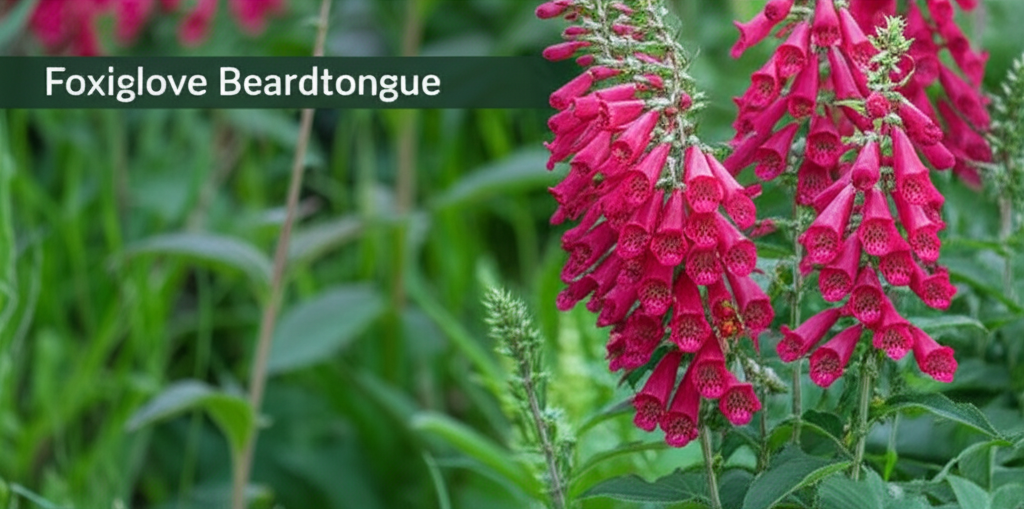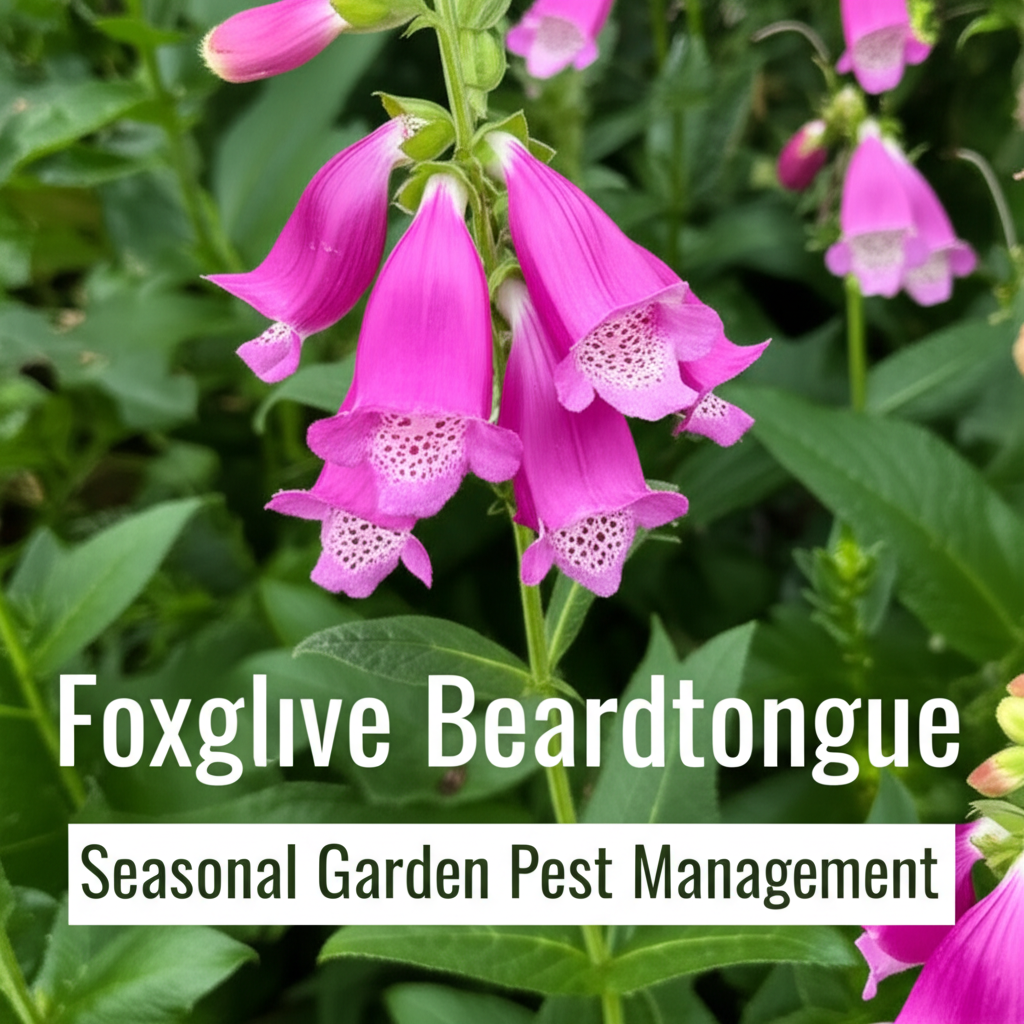The Allure and the Annoyance: Understanding Foxglove Beardtongue and its Pests
Foxglove Beardtongue (Penstemon digitalis) is a captivating native perennial that graces gardens with its tall, elegant spires of white to pale pink, tubular flowers. Blooming from late spring through early summer, it’s a magnet for pollinators, particularly bees and butterflies, making it a valuable addition to any wildlife-friendly garden. Its architectural presence and extended bloom time contribute significantly to landscape interest. However, like many beloved garden plants, Foxglove Beardtongue is not immune to the challenges posed by pests. Understanding these common adversaries and implementing proactive, seasonal management strategies is crucial to ensuring your Penstemon digitalis thrives and continues to provide its signature floral display.
This article will delve into the seasonal cycle of pest activity affecting Foxglove Beardtongue, providing a comprehensive guide to identification, prevention, and control. By adopting an integrated pest management (IPM) approach, focusing on observation, cultural practices, and targeted interventions, gardeners can effectively protect their plants and foster a healthy, vibrant garden ecosystem.
Understanding the Enemy: Common Pests of Foxglove Beardtongue

While generally hardy, Foxglove Beardtongue can be susceptible to a few common garden pests. Knowing what to look for is the first step in effective management.
Aphids (Hemiptera: Aphididae)
These tiny, soft-bodied insects are a ubiquitous garden nuisance. They typically congregate on new growth, buds, and the undersides of leaves, sucking sap from the plant. Heavy infestations can lead to stunted growth, distorted leaves, and a sticky residue called honeydew, which can attract sooty mold.
Spider Mites (Acari: Tetranychidae)
These microscopic arachnids thrive in hot, dry conditions. They spin fine webbing on the undersides of leaves and pierce plant cells to feed. Damage appears as stippling or bronzing of the foliage, eventually leading to leaf drop.
Thrips (Thysanoptera)
Small, slender insects, thrips feed by scraping plant surfaces and sucking the released juices. They can cause distorted flowers, silvery streaks on leaves, and can transmit plant viruses.
Slugs and Snails (Gastropoda)
These mollusks are most active in moist conditions, especially at night or during damp weather. They chew irregular holes in leaves and can damage flowers and stems, leaving behind tell-tale slime trails.
Leaf Miners (Insecta: Diptera, Hymenoptera, Coleoptera)
The larvae of various insects, leaf miners tunnel within plant leaves, creating winding, discolored trails. While typically not a major threat to established plants, severe infestations can weaken young plants and reduce photosynthetic activity.
Seasonal Garden Pest Management for Foxglove Beardtongue
Effective pest management for Foxglove Beardtongue is a year-round commitment, with specific actions being most beneficial during different seasons. An integrated approach, combining prevention, monitoring, and targeted control, yields the best results.
Early Spring: Laying the Groundwork for a Pest-Free Season
As the weather warms and Penstemon digitalis begins its spring growth, it’s an opportune time to prepare your garden and anticipate potential pest issues.
Cultural Practices for Prevention
- Sanitation is Key: Remove any lingering debris from the previous season, including dead leaves and stems, which can harbor overwintering pests or their eggs.
- Healthy Soil, Healthy Plant: Ensure your soil is well-draining and rich in organic matter. Healthy plants are more resilient to pest attacks. Amend the soil with compost before planting or as a top dressing in early spring.
- Proper Spacing: Give your Foxglove Beardtongue adequate space for air circulation. Overcrowding can create humid microclimates that favor pests like aphids and fungal diseases.
- Weed Control: Weeds can act as alternative hosts for pests and diseases. Keep the area around your Penstemon digitalis free of weeds.
Early Monitoring and Intervention
- Visual Inspection: Begin regular visual inspections of new growth for any signs of pests, such as tiny insects, webbing, or discoloration.
- Watering Wisely: Water at the base of the plant in the morning. This allows foliage to dry before nightfall, reducing conditions favorable to slugs, snails, and some fungal issues that can weaken plants and make them more susceptible to pests.
Late Spring to Early Summer: The Peak of Bloom and Pest Activity
This is the period when Foxglove Beardtongue is in full bloom, attracting pollinators but also providing a feast for emerging pests.
Targeted Pest Control Measures
- Aphid Control:
Water Spray: A strong blast of water from a hose can dislodge small aphid populations.
Beneficial Insects: Encourage natural predators like ladybugs, lacewings, and hoverflies by planting companion plants that attract them, such as dill, fennel, and yarrow.
Insecticidal Soap: For more persistent infestations, insecticidal soap is an effective, less toxic option. It disrupts the aphids’ cell membranes. Ensure thorough coverage, especially on the undersides of leaves.
- Spider Mite Management:
Increase Humidity: Mites dislike humidity. Misting the foliage (avoiding the hottest part of the day) can help deter them.
Horticultural Oils: Dormant oil or neem oil applications can smother mites and their eggs. Apply when temperatures are moderate.
- Slug and Snail Patrol:
Manual Removal: Handpick slugs and snails, especially in the early morning or late evening.
Barriers: Create physical barriers around plants using crushed eggshells, diatomaceous earth (reapply after rain), or copper tape.
Traps: Beer traps (shallow containers filled with beer) can effectively lure and drown slugs and snails.
- Thrips Mitigation:
Sticky Traps: Yellow or blue sticky traps can help monitor and capture flying adult thrips.
Pruning: Remove and destroy any heavily infested plant parts.
Summer: Maintaining Vigilance and Post-Bloom Care
As the peak bloom subsides, continued vigilance is necessary to manage any lingering pests and prepare the plant for the latter half of the season.
Ongoing Monitoring and Maintenance
- Continued Inspections: Keep an eye out for any returning pest populations, especially in drier spells which can favor spider mites.
- Deadheading: Removing spent flower stalks can encourage reblooming and prevent seed development, which can also stress the plant. This also removes potential hiding spots for some pests.
- Watering Consistency: Ensure consistent watering, especially during dry periods, to keep plants healthy and less stressed.
Fall: Preparing for Dormancy and Overwintering Pests
As the growing season winds down, focus shifts to preparing the plant for winter and reducing overwintering pest populations.
Fall Cleanup and Prevention
- Remove Debris: Cut back the spent flower stalks and foliage of Foxglove Beardtongue. Dispose of this material away from the garden to prevent overwintering pests.
- Soil Improvement: Apply a layer of compost or well-rotted manure to enrich the soil and provide a nutrient boost for the following spring.
- Mulching: A layer of mulch can help protect the plant’s roots from extreme winter temperatures and suppress emerging weeds in the spring. However, avoid piling mulch directly against the crown of the plant, as this can promote rot and provide shelter for slugs and snails.
Key Facts and Comparison of Pest Management Methods
To effectively manage pests on your Foxglove Beardtongue, understanding the strengths and weaknesses of various control methods is essential.
| Pest | Common Symptoms | Preventative Measures | Mechanical/Physical Control | Biological Control | Chemical Control (Least Toxic First) |
|---|---|---|---|---|---|
| Aphids | Stunted growth, sticky honeydew, distorted leaves | Healthy plants, proper spacing, attract beneficials | Water spray, pruning infested parts | Ladybugs, lacewings, hoverflies | Insecticidal soap, horticultural oil (neem oil) |
| Spider Mites | Stippling, bronzing, fine webbing | Adequate watering, avoid stressing plants, increase humidity | Water spray (can dislodge), pruning | Predatory mites | Horticultural oil, miticides (use as a last resort) |
| Slugs & Snails | Irregular holes in leaves, slime trails | Remove hiding places, keep garden clean, barriers | Handpicking, traps (beer) | Encourage ground beetles, birds | Iron phosphate baits (safer for pets/wildlife) |
| Thrips | Silvery streaks, distorted flowers, chewed surfaces | Monitor new growth, remove infested material | Sticky traps, pruning | Predatory mites, minute pirate bugs | Insecticidal soap, neem oil |
| Leaf Miners | Winding tunnels in leaves | Remove infested leaves, avoid planting near susceptible weeds | Pruning infested leaves | Parasitic wasps | Spinosad (when infestation is severe and unavoidable) |
Integrated Pest Management (IPM) Strategies: A Proactive Approach
Integrated Pest Management (IPM) is a holistic and sustainable approach to pest control that emphasizes prevention, monitoring, and using the least toxic methods first. For Foxglove Beardtongue, an IPM strategy would involve the following:
Steps in Implementing an IPM Strategy
- Prevention: Focus on creating a healthy environment that discourages pests. This includes proper plant selection, soil preparation, watering, and sanitation.
- Monitoring: Regularly inspect your plants for early signs of pest activity. Knowing what to look for and when is crucial.
- Identification: Accurately identify the pest to choose the most effective control method. Not all “bugs” are harmful.
- Action Thresholds: Determine when intervention is necessary. A few aphids might not warrant immediate action if beneficial insects are present, but a rapidly growing infestation might.
- Control Methods: Employ a hierarchy of control methods, starting with the least disruptive and moving to more targeted interventions only when necessary.
Pros and Cons of Different Pest Management Approaches
| Approach | Pros | Cons |
|---|---|---|
| Cultural Controls (Sanitation, Watering, Spacing) | Highly effective long-term, eco-friendly, no negative side effects, builds plant resilience. | Requires consistent effort and observation, may not fully eliminate severe infestations. |
| Mechanical/Physical Controls (Water spray, Handpicking, Traps) | Immediate impact, non-toxic, targeted. | Labor-intensive, may not reach all pests, effectiveness can be weather-dependent (traps). |
| Biological Controls (Beneficial Insects, Predatory Mites) | Self-sustaining once established, targets specific pests, no harm to beneficials or environment. | Takes time to establish, effectiveness can vary with environmental conditions, may require specific habitat to thrive. |
| Least Toxic Chemical Controls (Insecticidal Soap, Horticultural Oils, Neem Oil) | Effective against soft-bodied insects and mites, break down quickly in the environment, generally safer than broad-spectrum pesticides. | Requires careful application (timing, coverage), can still harm beneficial insects if not applied judiciously, may require repeat applications. |
| Synthetic Chemical Controls (Broad-spectrum Insecticides/Miticides) | Rapid and effective for severe infestations. | Can harm beneficial insects, pollinators, and wildlife; can lead to pest resistance; potential environmental contamination; residual effects. (Should be used only as a last resort and with extreme caution). |
Conclusion: Cultivating a Resilient Garden
Foxglove Beardtongue is a rewarding plant for any garden, offering stunning visual appeal and vital support for pollinators. By understanding the seasonal patterns of common pests and implementing a robust, integrated pest management strategy, gardeners can enjoy the beauty of their Penstemon digitalis with minimal disruption. Remember, a healthy garden ecosystem is your best defense. By prioritizing preventative measures, fostering beneficial insects, and using targeted, environmentally conscious control methods, you can ensure your Foxglove Beardtongue flourishes year after year, a testament to your mindful gardening practices.


